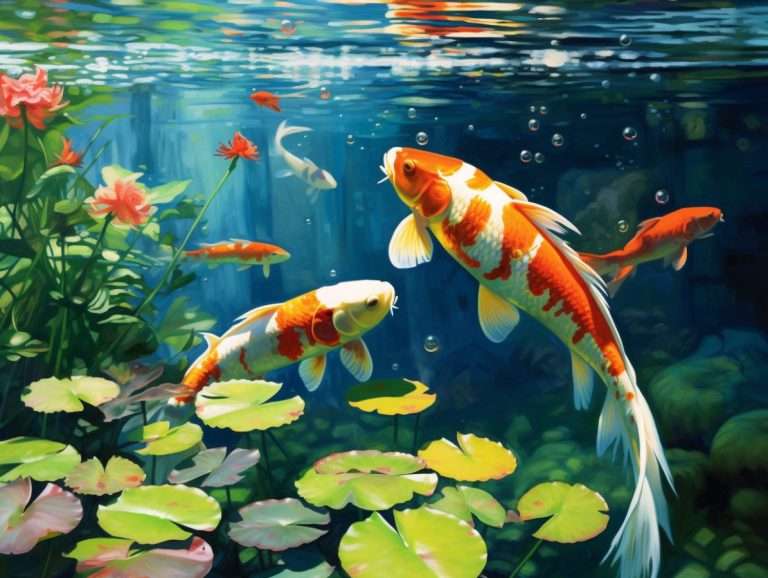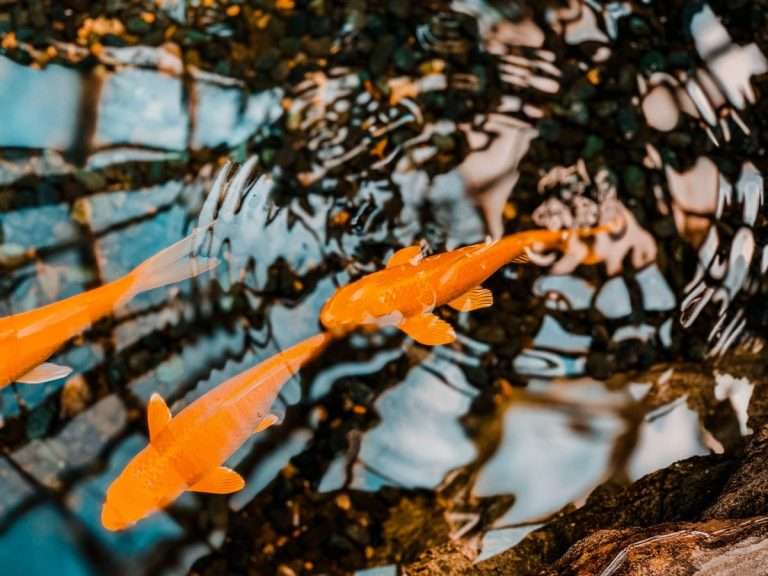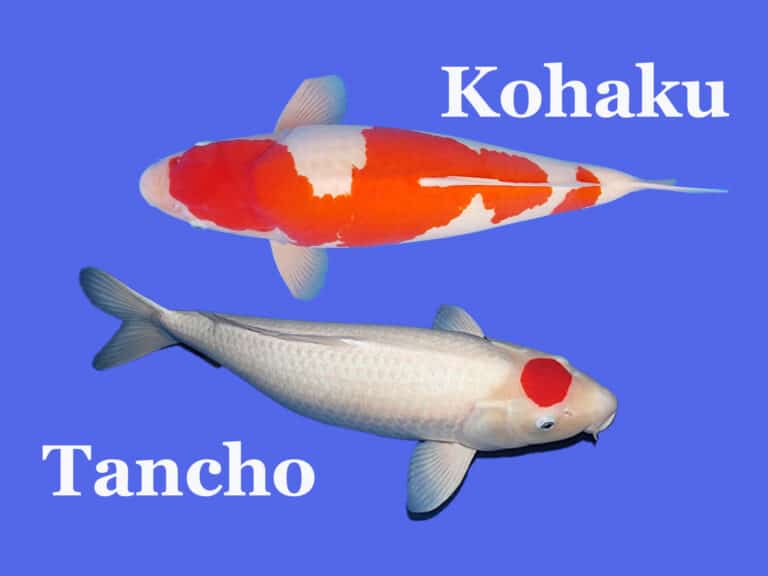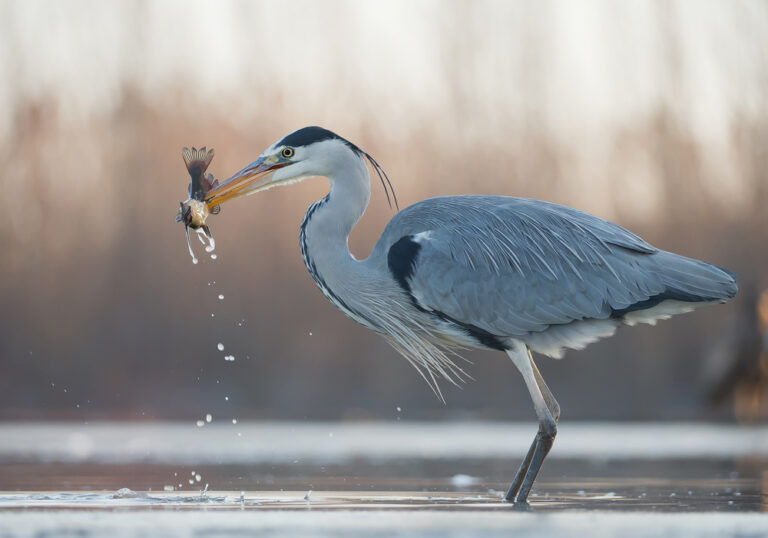Secrets to Keeping Your Koi Fish Happy and Healthy in Your Pond
Our aquatic friends need plenty of love and attention if we want them around for a long time. Koi ponds are becoming increasingly popular due to their ability properly care for areas with a Zen-like tranquility that is difficult to find elsewhere. However, properly caring for them requires keeping your koi fish happy.
Basics Of Koi Care
Koi care is an integral part of keeping your pond healthy and beautiful. It’s essential to know the basics before getting started. Firstly, you need to find a suitable environment for koi in terms of water temperature, pH levels, and quality. The ideal range for temperature should be between 65-85°F (18-29°C). The optimal pH level should be around 7.0 or slightly higher. Add air pumps if needed to ensure your fish have plenty of oxygen.
Next up are nutrition and diet requirements. Koi require high-protein foods such as bloodworms, daphnia, brine shrimp, etc., which they can feed thrice daily. Also, make sure to vary their diet with occasional treats like cooked peas or lettuce leaves – these contain carbohydrates that help release energy stored in proteins and fats from other food sources. To keep them at their best health-wise, it’s crucial to provide balanced meals regularly so that they get all the nourishment they need without overfeeding them.
Finally, regular maintenance is vital when caring for koi in ponds – this includes cleaning filters regularly; checking ammonia & nitrates levels; performing partial water changes every two weeks; removing debris and waste from the bottom of the pond; as well as inspecting fish daily for any signs of illness such as discoloration or loss of appetite. These steps will help create a safe and pleasant home environment for your koi while keeping your koi fish happy.
Introducing New Fish To The Pond
Adding new fish to a pond can be exciting, but doing so safely and responsibly is essential. It is widely believed that introducing multiple koi at once helps them acclimate easier since they have one another for comfort in the unfamiliar environment. However, this theory should not be taken lightly; adding too many fish all at once can cause overcrowding and introduce disease into the pond. To ensure that your koi are safe and happy when introducing new additions, follow these steps:
- Quarantine New Fish:
- Before adding new fish to the pond, quarantine them in a separate tank with their filter system for two weeks. This allows you to observe each individual without contaminating other populations.
- Monitor water parameters during this period and look closely for signs of parasites or disease on each fish’s body before deciding whether or not to add them to the leading group.
- Add One at a Time:
- Once you’ve determined that the quarantined fish are healthy, add only one per week until they are all integrated into the main population of koi.
- Doing so reduces stress levels amongst old and new family members while allowing ample time for everyone to become familiar with their surroundings. Additionally, if something were to go wrong after introduction, it would make isolating any potential problem much more accessible than if more than one had been added simultaneously.
- Stay Vigilant:
- After integrating new members into the main population, monitor water quality regularly and watch out for any changes in behavior from either existing or newly-added fish – especially aggressive behavior between individuals, which may indicate territorial disputes or illness within the group.
- If anything seems amiss, remove affected individuals from the pond until further investigation can be completed and the appropriate treatment is administered if necessary.
In summary, following proper protocols when introducing new koi will help keep current populations healthy while providing newcomers with a comfortable transition into their homes away from home! With patience and vigilance every step of the way, along with regular maintenance checks on your equipment, you’ll surely enjoy every moment spent admiring your finned friends in no time!
Diet For Optimal Health
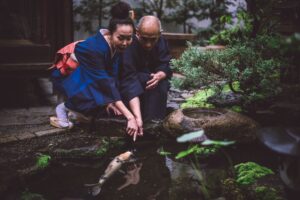
First off: don’t skimp on food quality for your fish. You get what you pay for here; top-of-the-line foods contain higher amounts of essential vitamins and minerals, which help promote vigorous growth rates and optimal coloration in your Koi. And if you’re looking to save money? Look into buying in bulk – you can provide high-quality meals without breaking the bank.
Finally, feed your koi various food sources: pellets or flakes are great staples, but don’t forget to add some fresh greens like duckweed or water lettuce occasionally too! Supplementing with live food such as worms is also beneficial — not only does this give your fish something natural to hunt down (which keeps them stimulated), but they also have the bonus of being incredibly nutritious for them as well!
So there you have it: with just these few tips on feeding habits alone, you can ensure that your beloved pond companions stay happy and healthy for many years.
Water Quality Checks
Koi fish need a healthy and balanced environment to survive in your pond. That’s why it is essential to monitor the water quality regularly. This can be done by testing for various parameters such as temperature, pH, dissolved oxygen levels, salinity, and ammonia levels.
The following table illustrates what kind of values you should strive for when monitoring your pond’s water quality:
| Parameter | Ideal Value |
|---|---|
| Temperature | 65-80°F (18-27°C) |
| pH | 7-8 |
| Dissolved Oxygen | 6ppm or above |
| Salinity | 0 ppt |
| Ammonia Levels | 0 ppm |
You should use high-quality test kits to ensure that these readings are accurate. Additionally, perform regular filter cleaning and partial water changes to keep your koi happy and healthy. Doing so will help maintain optimal conditions for them in the long run.
It is also essential to pay close attention to any unusual behavior from your koi fish – this could indicate something is wrong with their habitat. If you notice anything uncommon regarding their health or wellbeing, contact an expert who can provide further advice on caring for your beloved pets!
Appropriate Pond Size

The size of the pond is essential in determining how successfully your koi fish will thrive. To illustrate this, consider an Olympic-sized pool: it might look inviting on a hot day, but jumping right into it without any preparation or experience, can be pretty overwhelming! The same applies to selecting the proper tank size for your koi fish. It needs to have enough space and depth so they can swim freely and explore their environment while still feeling safe and secure.
Your chosen tank should be at least 75 gallons with 18 inches or more depth. This allows plenty of room for swimming around and offers shelter from predators such as birds or cats. The width should also provide adequate space between each koi fish; otherwise, overcrowding may lead to stress and disease. Additionally, the water must always remain clean – regular maintenance includes regular water changes and filter cleaning.
A larger tank does not necessarily mean better conditions for your koi fish, either. Too much space can cause problems like poor oxygen levels, leading to lethargy and illness. There’s no one-size-fits-all solution to finding the perfect home for your koi friends – what works best depends on many factors, including the number of visitors that visit them every day! Ultimately, research different options before deciding –your koi’s health could depend on it!
Temperature Range Requirements
Koi need to be kept in temperatures ranging from 65-78 Fahrenheit (18-25 Celsius). Keeping your water temperature within this range is essential for their wellbeing. Here are the three most important things you should keep in mind when controlling the pond’s temperature:
- Make sure the pond doesn’t get too hot or cold; sudden changes can stress your fish and make them sick.
- Install a reliable thermometer so that you can accurately monitor your pond’s temperature.
- Use an aerator to help with circulation, which helps maintain a more consistent temperature throughout the entire body of water.
It’s also important to remember that even slight temperature differences can significantly affect koi health. For example, if it gets too warm, they may become less active, while if it becomes too cold, they could go into hibernation mode and die! Therefore, always pay close attention to how quickly temperatures change and adjust accordingly. Additionally, having shades over your pond during summer months will help reduce heat levels and provide shelter for your fish during storms.
Keeping track of these details is vital for providing an optimal environment for your koi. The better care you take of them now by regulating temperature properly, the healthier and happier they’ll be!
Protective Measures From Predators
Now that we understand the temperature range requirements for keeping your koi fish healthy and happy let’s talk about protective measures from predators.
Predators are a common concern when it comes to pond stocking; however, there are various methods you can use to protect your koi fish in their habitat.
The following table outlines some vital protective measurements:
| Predation Prevention | Description |
|---|---|
| Netting | Install netting around the perimeter of your pond to keep out birds or other animals. |
| Pond Depth | If possible, ensure your Koi have at least 4 feet of water depth to hide in. This will help them stay safe from predators like raccoons and cats. |
| Fencing | Constructing a fence around the perimeter of your pond may also be an option depending on the size and type of predator present. It should be high enough so they cannot jump over it but low enough so you can still maintain visual contact with your Koi friends. |
| Artificial Structures | Adding artificial structures like rocks and plants gives Koi places to hide and provides food sources for smaller species like minnows, which act as natural deterrents against larger predatory species. |
These simple steps can ensure that your Koi remain safe from potential predators while they live happily in their new home. Taking these precautions is essential for protecting our beloved Koi and all aquatic life within the pond ecosystem!
Signs Of Stress Or Illness In Koi Fish
It can be a real bummer when your beloved koi fish show signs of being stressed or ill. It’s like caring for a pet, only with the bonus of never having to take them out for walks! But how do you know if they’re feeling under the weather?
Well, some key indicators might signal something is up:
- their appetite may decrease, and they won’t feed as eagerly as usual;
- color changes – red patches could indicate a bacterial infection, while white spots on the fins might suggest parasites;
- lethargy – this can be an indicator of water quality issues such as ammonia poisoning.
As a pond specialist, I recommend regular monitoring of all these signs. Paying attention to changes in appearance or behavior should indicate it’s time for action. If untreated, any stressors or illnesses can lead to serious health problems for your fish. So keep your eyes peeled, and don’t hesitate to contact an expert if needed – no matter how small the issue initially seems. After all, prevention is always better than cure!
Treatments To Restore Health And Vitality
Treating your koi fish with the proper remedies can be an effective way to restore health and vitality. Some common treatments can help keep your koi in top condition, such as adding salt or medication to the pond water or providing exceptional food for ill fish.

Special foods for sick fish contain essential vitamins and minerals that boost immune system function and aid recovery from illness. Lastly, regular water changes should be done to ensure high-quality conditions and remove toxins that may cause sickness amongst your koi population. All these measures will go a long way towards ensuring your koi stay healthy and vibrant!
After taking the necessary steps to restore health and vitality, keeping your koi fish happy and healthy is essential. You’ll need to create an environment that meets their needs to do this. Here are some tips on ensuring your pond is a haven for your koi friends.
First of all, ensure that your water’s temperature remains consistent throughout the year. Ideally, aiming for temperatures between 65-75°F (18-24°C) would be best. This will ensure your koi stay active and vibrant year-round. You may also want to consider investing in a heater if needed – especially during winter months or cold snaps. Additionally, use filters or pumps as necessary to maintain water quality by removing any odors, excess waste, ammonia levels & other pollutants that can harm your fish.
Secondly, please provide them with enough space! Just like us humans, they need plenty of room to move around and explore without bumping into each other too much – overcrowding could lead to stress & illness amongst them.
Keep at least 1 square foot per inch of adult koi size when stocking your pond; larger ponds are even better if possible! Last but not least important is providing ample amounts of food such as worms/bloodworms, pellets, or flakes depending on what type of diet works best for them – don’t overfeed so there isn’t waste left in the bottom of their home!
Keeping these simple guidelines in mind will help ensure success in keeping your beloved koi thriving and happy long term! With proper care from the day, you’ll have years of joyous moments spent admiring these majestic creatures swimming in their natural habitat –your backyard paradise!
Regular Cleaning Routine
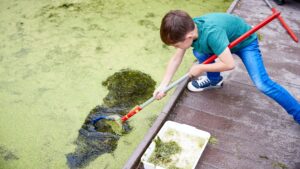
The key to thriving koi is a healthy pond environment, and it’s up to the fish keeper to ensure their watery home remains in top shape. Regularly cleaning your pond’s surface, substrate, filter systems, and pumps should become part of your routine maintenance schedule.
Taking care of these aspects will benefit your fish and keep their habitat free from disease-causing organisms and other pollutants, which could otherwise prove hazardous for both humans and animals alike.
It doesn’t need to be laborious or time-consuming – just a few simple steps such as skimming off debris from the surface daily (or weekly if needed) and spending some quality time giving your filtration system and pump a good clean each month will go a long way towards providing your koi with the best living conditions possible.
It’s also essential to change the substrate periodically to reduce the build-up of organic matter; this helps maintain oxygen levels too. With these tips in mind, you can start working toward creating a happy and healthy environment for your precious pets.
The next step for creating a thriving koi environment is to ensure the water remains balanced. This means testing pH levels regularly and maintaining proper alkalinity and hardness of the water. Additionally, watch for signs of stress or illness, such as rapid breathing, erratic swimming movements, pale coloration, lesions, or scale inflammation. A good rule of thumb is that if you can’t test these things yourself, consider hiring a professional who can do it for you.
Also, be sure to provide ample space for them to swim around in their pond; this will help prevent overcrowding which can lead to disease and other issues with your fish. If possible, add some plants like lilies or lotus flowers, which can act as natural filters while providing shade from direct sunlight. Plenty of rocks and gravel at different depths throughout the pond are great ways to give them places to feel secure when not actively swimming around.
Feeding Frequency And Timing Guidelines
Koi fish need to be fed a proper diet, and providing them regularly is essential. On average, koi should consume about 2-4% of their body weight daily. This means that if you have an adult koi weighing 10 pounds, they will need between 0.2 to 0.4 pounds of food each day! Feeding your koi the right amount at the right time is essential for keeping them healthy and happy in your pond.
When feeding your koi, distribute the food evenly throughout the water. You want your fish to get equal amounts so no one goes hungry or overeats. It’s also best not to feed too much as this can lead to poor water quality and health issues with your fish over time. The ideal times to provide are during daylight hours when the temperature outside is above 50 degrees Fahrenheit or below 90 degrees Fahrenheit; avoid feeding late at night because that can disturb their natural sleeping cycles and cause stress on their bodies.
To keep things manageable, plan out what days and times you would like to feed your koi ahead of time and stick with that schedule for consistency purposes – this helps establish a routine and ensures your koi receive a balanced diet without ever going hungry or overeating! Please provide any uneaten food removed from the pond after 20 minutes, so it does not contaminate the water; using a net works well for this purpose. With these simple tips, you can ensure your beloved koi eat happily and remain healthy in your pond!
Keeping your koi fish happy and healthy in your pond isn’t difficult. It just requires regular maintenance, care, and attention to detail! Here are some tips for how you can ensure the well-being of your beautiful koi:
First off, keep the water clean. This is crucial for maintaining good health and preventing diseases from spreading amongst your fish population. Change out 10-20% of the water weekly or as needed to keep it fresh. Ensure you use a de-chlorinator when adding new water to the pond so that chlorine doesn’t kill off beneficial bacteria or damage delicate scales on the fish’s bodies. Additionally, be mindful of what kind of food you’re feeding your fish – high-quality food will help them grow strong and stay active.
Next up, ensure plenty of oxygen is circulating throughout the pond environment by having an aerator set up at all times. In addition to helping with water circulation, this also prevents toxic gases from building up inside the pond, which would otherwise suffocate its inhabitants.
Also, consider providing shade areas for your fish during hot days; Koi prefer cooler temperatures than most aquatic creatures! Lastly, check regularly for signs of stress, such as listlessness or aggressive behavior – these could indicate something amiss with their living conditions. If noticed early enough, appropriate steps can be taken to rectify any issues before they become too serious!
By following these simple tips, you’ll have contented koi swimming around happily in no time! With proper care and attention given to their needs, these animals can live long lives full of joy and vitality – both yours to enjoy!
Conclusion
Koi fish are a fantastic addition to any pond but require special care. With proper attention and suitable precautions, you can ensure your koi stay happy and healthy for many years. Taking the time to introduce new fish slowly, feed them according to their dietary needs, check water quality regularly, and keep a regular cleaning routine will help ensure your koi live long lives full of joy. And don’t forget: when it comes to keeping your koi well-cared for, “an ounce of prevention is worth a pound of cure”!
By following these guidelines, you can rest assured that I’ve done my part to ensure your beloved pet fish have everything they need! Regular maintenance checks provide peace of mind andalso allow me to spot early signs of potential illness so we can take action quickly if needed. Plus, with consistent upkeep, we can avoid potentially disastrous situations caused by neglect or overfeeding, which could spell disaster for our finned friends.
So go forth confidently, knowing that with just a few simple steps, you can create a haven for all your cherished koi! Ensuring their habitat is clean and inviting will bring plenty of smiles (and bubbles!) as they swim around contentedly in their paradise.
Originally posted 2023-03-18 08:36:43.





